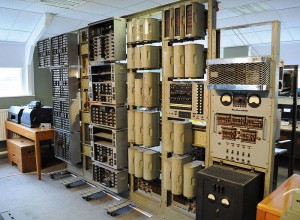The WITCH Rises – Dekatron Computing
Recently another antique computer was restored to working condition. Originally called the Harwell Dekatron, the WITCH (Wolverhampton Instrument for Teaching Computing from Harwell) was built in 1949-1951. Back in the early days of computing, it often took years to build a computer, rather then the minutes it takes to make a iPhone in today’s factories.
The WITCH was a decimal computer, storing data not in 0’s and 1’s of the transistor age, but actual decimal digits. It originally could store 20 8 digit numbers (0-99,999,999 or 23 binary bits) but later was upgraded to support up to 40, which was considered more then enough (such short sighted statements did not end in the 50’s, if you’ll remember Bill Gates comment about 640k of RAM is all anyone would need.) Data on the WITCH was stored on Dekatron tubes, a Cold-cathode device filled with Neon (or Argon) that could represent 10 digits. Sending a pulse to the Dekatron would cause the glowing Neon dot (and its associated high voltage) to move from cathode to cathode, thus allowing data to be stored. One side effect of having decimal data, and glowing orange dots for volatile storage is you can literally SEE what is in memory.
The WITCH was mainly used to perform mathematical computations. It was not a fast computer, it took it a good 10-15 seconds to perform a multiplication. Many humans with adding machines could actually work the problems faster, however the WITCH never complained of carpal tunnel nor did it need breaks. The Harwell Dekatron was slow, but is was steady and quite reliable. It could go for days (providing it had enough problems fed to it on paper tape) without error or breakdown and that is what made it so useful and worth restoring.
Check out the BBC article and video of its operation and listen to the relays click, and see the glowing Neon of computational history.
Posted in:
Museum News



